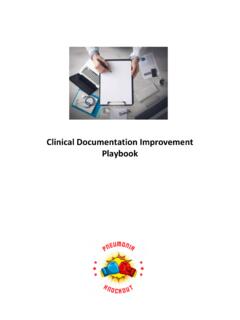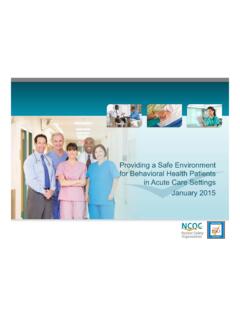Transcription of IHI Framework for Improving Joy in Work - NCHA
1 IHI Framework for Improving Joy in Work AN IH I RES OUR CE 20 University Road, Cambridge, MA 02138 How to Cite This Paper: Perlo J, Balik B, Swensen S, Kabcenell A, Landsman J, Feeley D. IHI Framework for Improving Joy in Work. IHI White Paper. Cambridge, Massachusetts: Institute for Healthcare Improvement; 2017. (Available at ) WHITE P APER AUTHORS: Jessica Perlo, MPH: Network Director, IHI Open School Barbara Balik, RN, EdD: Senior Faculty, IHI, and Co-founder, Aefina Partners Stephen Swensen, MD: Medical Director for Professionalism and Peer Support, Intermountain Healthcare, and Senior Fellow, IHI Andrea Kabcenell, RN: Vice President of Innovation, IHI Julie Landsman: Project Coordinator, IHI Derek Feeley: President and CEO, IHI Acknowledgements: IHI would like to thank the following organizations for their contribution to the IHI Framework for Improving Joy in Work: American Medical Association; Barry Wehmiller; Baylor Scott & White Health; Bellin Health Systems; Beth Israel Deaconess Medical Center; Brigham and Women s Hospital; Gaylord Hotels; Google.
2 Healthcare Transformation Project at ILR School of Cornell University; Hospitality Quotient; Hospital Quality Institute; Iora Health; Mayo Clinic; Menlo Innovations; Samueli Institute; Service Employees International Union; Starbucks; Veterans Health Administration; and Zappos. We would also like to thank the following organizations that participated in prototype testing of the Framework : American Association of Critical Care Nurses; Charleston Area Medical Center; Glen Cove Hospital, Northwell Health; iMatter NHS Scotland; Imperial College Healthcare NHS Trust; Kaiser Permanente Erwin Street Medical Offices; Mount Auburn Hospital Labor and Delivery; Nemours/Alfred I. DuPont Hospital for Children Pediatric Intensive Care Unit; NHS Highland; Penn State Altoona; University of Michigan Cardiac Intensive Care Unit; and University of Virginia School of Nursing.
3 The authors are grateful for the thought leadership provided by IHI Leadership Alliance members who participated in the Joy in Work Workgroup and helped to frame the basic concepts as they apply to health care. We also thank Jane Roessner, Val Weber, and Don Goldmann of IHI for their support in developing and editing this white paper. The authors assume full responsibility for any errors or misrepresentations. The Institute for Healthcare Improvement (IHI) is a leading innovator in health and health care improvement worldwide. For more than 25 years, we have partnered with a growing community of visionaries, leaders, and frontline practitioners around the globe to spark bold, inventive ways to improve the health of individuals and populations. Together, we build the will for change, seek out innovative models of care, and spread proven best practices.
4 To advance our mission, IHI is dedicated to optimizing health care delivery systems, driving the Triple Aim for populations, realizing person- and family-centered care, and building improvement capability. We have developed IHI s white papers as one means for advancing our mission. The ideas and findings in these white papers represent innovative work by IHI and organizations with whom we collaborate. Our white papers are designed to share the problems IHI is working to address, the ideas we are developing and testing to help organizations make breakthrough improvements, and early results where they exist. Copyright 2017 Institute for Healthcare Improvement. All rights reserved. Individuals may photocopy these materials for educational, not-for-profit uses, provided that the contents are not altered in any way and that proper attribution is given to IHI as the source of the content.
5 These materials may not be reproduced for commercial, for-profit use in any form or by any means, or republished under any circumstances, without the written permission of the Institute for Healthcare Improvement. Institute for Healthcare Improvement 3 Contents Foreword 4 Executive Summary 5 Introduction 5 Four Steps for Leaders 8 IHI Framework for Improving Joy in Work 16 Measuring Joy in Work 21 Conclusion 22 Appendix A: What Matters to You? Conversation Guide 23 Appendix B: Change Ideas for Improving Joy in Work 27 Appendix C: Assessment Tools for Improving Joy in Work 33 References 38 WHITE PAPER: IHI Framework for Improving Joy in Work Institute for Healthcare Improvement 4 Foreword Okay, I admit it. Joy in work sounds flaky. That was the reaction a friend of mine had when I suggested a couple of years ago that she add that to the strategic goals she was exploring with her team on a day-long management retreat.
6 She did try, and her report back to me was this: They hated it. They said, Get real! That s not possible. Sad to say, I suspect that may still be the response of all too many workgroups and leaders, both inside and outside health care. Hunkering down, getting through the day, riding out the storm these are much more familiar attitudes in inevitably stressed work environments, as truly good people try hard to cope with systems that don t serve them well, facing demands they can, at best, barely meet. The closest most organizations come to joy is TGIF parties Thank goodness it s Friday. I made it through another week. It has long seemed a paradox to me that such depletion of joy in work can pervade as noble and meaningful an enterprise as health care. What we in the healing professions and its support roles get to do every day touches the highest aspirations of a compassionate civilization.
7 We have chosen a calling that invites people who are worried and suffering to share their stories and allow us to help. If any work ought to give spiritual satisfaction to the workers, this is it. Joy, not burnout, ought to rule the day. In our work in health care, joy is not just humane; it s instrumental. As my colleague Maureen Bisognano has reminded us, You cannot give what you do not have. The gifts of hope, confidence, and safety that health care should offer patients and families can only come from a workforce that feels hopeful, confident, and safe. Joy in work is an essential resource for the enterprise of healing. Good news! Joy is possible. We know it is possible, not only from intuition, but also from science. This IHI White Paper summarizes a surprisingly large literature on theory and evidence about factors, such as management behaviors, system designs, communication patterns, operating values, and technical supports, that seem associated with better or worse morale, burnout, and satisfaction in work.
8 It also cites a growing number of health care organizations that are innovating in pursuit of joy in work, and often getting significant, measurable results. (One of those organizations is IHI, itself, whose local projects are worth studying.) Since joy in work is a consequence of systems, quality improvement methods and tools have a role in its pursuit. That is to say: organizations and leaders that want to improve joy can do so using the same methods of aim setting, tests of change, and measurement that they use in the more familiar terrain of clinical and operational process improvement. So, listen up! Joy in work is not flaky, I promise you. Improving joy in work is possible, important, and effective in pursuit of the Triple Aim. This IHI White Paper will help you get started. And you might well find that the joy it helps uncover is, in large part, your own.
9 Donald M. Berwick, MD President Emeritus and Senior Fellow Institute for Healthcare Improvement WHITE PAPER: IHI Framework for Improving Joy in Work Institute for Healthcare Improvement 5 Executive Summary With increasing demands on time, resources, and energy, in addition to poorly designed systems of daily work, it s not surprising health care professionals are experiencing burnout at increasingly higher rates, with staff turnover rates also on the rise. Yet, joy in work is more than just the absence of burnout or an issue of individual wellness; it is a system property. It is generated (or not) by the system and occurs (or not) organization-wide. Joy in work or lack thereof not only impacts individual staff engagement and satisfaction, but also patient experience, quality of care, patient safety, and organizational performance.
10 This white paper is intended to serve as a guide for health care organizations to engage in a participative process where leaders ask colleagues at all levels of the organization, What matters to you? enabling them to better understand the barriers to joy in work, and co-create meaningful, high-leverage strategies to address these issues. The white paper describes the following: The importance of joy in work (the why ); Four steps leaders can take to improve joy in work (the how ); The IHI Framework for Improving Joy in Work: nine critical components of a system for ensuring a joyful, engaged workforce (the what ); Key change ideas for Improving joy in work, along with examples from organizations that helped test them; and Measurement and assessment tools for gauging efforts to improve joy in work.











